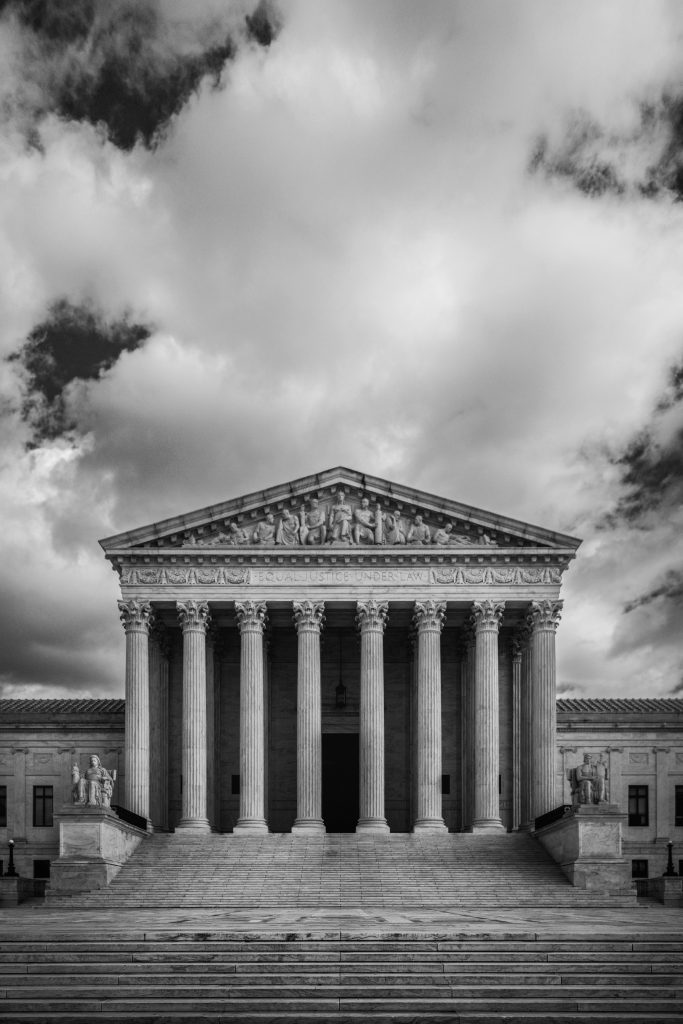
Photo Courtesy of Tim Mossholder, 2023 via Unsplash
By: Nathan Giercyznski, Staff Writer
From its founding in 1789, the United States government has blazed the trail for democratic nations everywhere. This constitutional republic is viewed by countries worldwide, at least philosophically, as what Ronald Reagan described as a “shining city on a hill.”[1] However, the United States government has one incredibly unique feature that few are aware of – unfettered, lifetime tenure for the judges on the highest courts in the land.
The vast majority of developed democracies in the world limit the tenure of their judges, either through a mandatory retirement age or a set term of years. Federal judges in the United States share life tenure with only one other court in the world, Aruba’s Joint Court Judges.[2] How did America take such a radically different course? The answer likely can be found in Federalist 78, where Alexander Hamilton made his case for the American judiciary, explicitly rejecting limited tenure for the federal judiciary and making two critical arguments for life tenure. The first argument was that a termed judiciary is more likely to be accountable to whoever places them in office, be it the executive or legislative power.[3] The second turned on the idea that age begets wisdom. A judiciary will be less equipped to handle complex matters of law when the bench is filled with judges who have little experience and will be removed from the bench before they can gain experience.[4] But as Oscar Wilde famously said, “[w]ith age comes wisdom, but sometimes age comes alone.”[5] This is the crux of the push to impose tenure limits.
There are two generally accepted manners of limiting judicial tenure. The first is by a set term of years. This concept is applied to nearly every other elected federal official in the United States. The president serves a four (4) year term; senators serve a six (6) year term, etc. Of course, only the president has term limits; they can serve a maximum of eight (8) years. However, this is not an unprecedented concept in American judicial systems. Every state in the Union, besides Rhode Island, imposes either a term limit or a mandatory retirement age on their Supreme Court justices.[6] So how can the tenure of federal judges be limited? Diane P. Wood argues for an 18-year term limit, asserting that the Supreme Court, in particular, is not what the Framers envisioned. It risks becoming out of touch with the American people as justices lifespans become longer, extending their terms by decades .[7] In this model, judges would be forced to assume senior status as Article III judges when their terms expire, just as many voluntarily do in the existing framework. However, there are serious problems with the implementation of term limits in that framework, and many argue that term limits for federal judges would not be constitutional.
A simple solution that aligns more closely with Alexander Hamilton’s vision of the federal judiciary is a mandatory retirement age (MRA). As of 2022, thirty-one (31) states and the District of Columbia have instituted an MRA for their judges, generally ranging from ages seventy (70) to seventy-five (75), with Vermont setting its MRA at ninety (90).[8] England has imposed mandatory retirement on all of its judges since 1959 and the mandate is a defining feature of their judiciary.[9] An MRA for federal judges could be more politically acceptable and easier to implement than set terms. Theoretically, judges already older than the MRA at its implementation could be given the option to retire to senior status or serve until they are ready to retire. Judges younger than the MRA would be bound to it.
There are certainly valid questions about the constitutionality of limiting federal judicial tenure in any way. Set terms are more likely to be unconstitutional than the MRA. Hamilton makes it clear it Federalist 78 that one of the primary drivers of life tenure is the value of experience and wisdom. Set terms would do far more damage to this ideal than an MRA. Suppose a person is appointed to the federal bench at the age of forty (40). Under the most prominent set term theory, that judge would be forced into retirement at fifty-eight (58). If there was an MRA of seventy (70), the nation could get twelve (12) more years of valuable, experienced service from that judge. This method is far closer to Hamilton’s vision.
America has taken a different approach to its administration of the federal judiciary than other similarly governed nations and it has led to judges serving life terms while becoming increasingly out of touch with the American people. But there is an acceptable solution. The implementation of a mandatory retirement age would help keep the judiciary in touch with the evolving views of people and return the United States to the forefront of leadership in the democratic world.
[1] https://www.reaganlibrary.gov/archives/speech/farewell-address-nation
[2] https://judiciariesworldwide.fjc.gov/judicial-tenure#:~:text=Supreme%20court%20justices%20may%20be,7%20%E2%80%93%2012%2Dyear%20term.
[3] https://avalon.law.yale.edu/18th_century/fed78.asp
[4] https://avalon.law.yale.edu/18th_century/fed78.asp
[5] https://www.goodreads.com/quotes/329316-with-age-comes-wisdom-but-sometimes-age-comes-alone
[6] https://ballotpedia.org/Length_of_terms_of_state_supreme_court_justices
[7] https://www.brennancenter.org/our-work/analysis-opinion/why-term-limits-supreme-court-justices-make-sense
[8] https://ballotpedia.org/Mandatory_retirement
[9] https://consult.justice.gov.uk/digital-communications/judicial-mandatory-retirement-age/supporting_documents/judicialmandatoryretirementageconsultation.pdf